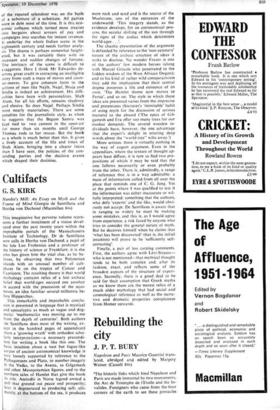Rebuilding the
J. P. T. BURY
Napoleon and Paris Maurice Guerrini trans- lated, abridged and edited by Margery Weiner (Cassell 84s)
The historic links which bind Napoleon and Paris are made immortal by two monuments, the Arc de Triomphe de l'Etoile and the In- valides. Foreigners who came from the-four corners of the earth to see these pinnacles
of his glory pay homage simultaneously to the Man and to the City, These two con. eluding sentences of M. Guerrini's book with their revealing capital letters give some indication of the spirit in which the author, a senior civil servant, has written it. It is one both of deep affection for the City and uncritical admiration of the Man. He has attempted to give both a general account of Napoleon's relationship with the Parisians— a difficult task—and a particular account of his building projects and the material im- provements which loomed so large during his rule. Since the treatment is chronological the two accounts are interwoven. In the first aim he is less successful than in the second because he treats Napoleon's relationship with what, as Emperor, he delighted to call 'his good city of Paris' as a romance. Thus he minimises discontent and quotes official newspapers (and what newspapers were not official by the end of the reign?) and police reports without a hint that they might be doctored or reflect only what Napoleon wished to hear. Again, when the number of theatres was reduced in 1807 the only motive he adduces is that the Emperor 'wanted to end the competition of boulevard plays'. The deliberate muzzling of public opinion is ignored.
M. Guerrini is less biased in his survey of Napoleon's plans to make Paris 'not only the most beautiful city in being, but the most beautiful which had ever been or would ever be'. Although there are passages relating to building projects and tours of inspection which in this abridgement read too much like a catalogue, these sections of his book are full of fascinating details of social and architectural history. His survey-begins with a brief but illuminating glimpse of Paris in 1800, a glimpse sharpened by comparative figures to rejoice the statistically minded. Thus we are told that there were some 1,100 streets compared with 3,940 in 1964, that they were winding, narrow and ill lit—('there were only 9,890 lamp-posts and 4,500 oil lamps or lanterns')—and that their average width being 24 feet. Napoleon, it should be said, wanted them all to be 40 feet broad.
Although Napoleon was preoccupied with his own reputation—'Men are great only by the monuments they leave behind', he de- clared in 1809—he was also genuinely con- cerned to improve living conditions. From the outset he sought to increase the water supply and improve arrangements for the care of the sick and the burial of the dead. He ordered the construction of a canal from the River Ourcq to a basin at La Villette, the principle of one patient to a bed was recog- nised (whether it was honoured was another matter), and the three new cemeteries of Montmartre, Pere Lachaise and Vaugirard were planned. By 1811, when his difficulties were accumulating, works of public utility took priority and he said that four of the most important were 'the waters of the Ourcq, the new buildings for the Central Markets, the slaughterhouses, and the Wine Market'. Although the building trades boomed and the Grand Duke of Wurttem- berg once told Napoleon that Paris 'looked very well for a city taken by assault by the architects', Napoleon had neither the time nor the money to complete or even begin many of his projects. In appendices M. Guer- rini prints useful lists of roads and quays as well as of buildings begun or restored under the Consulate or Empire together with their dates of completion and remarks upon their subsequent fate.







































 Previous page
Previous page